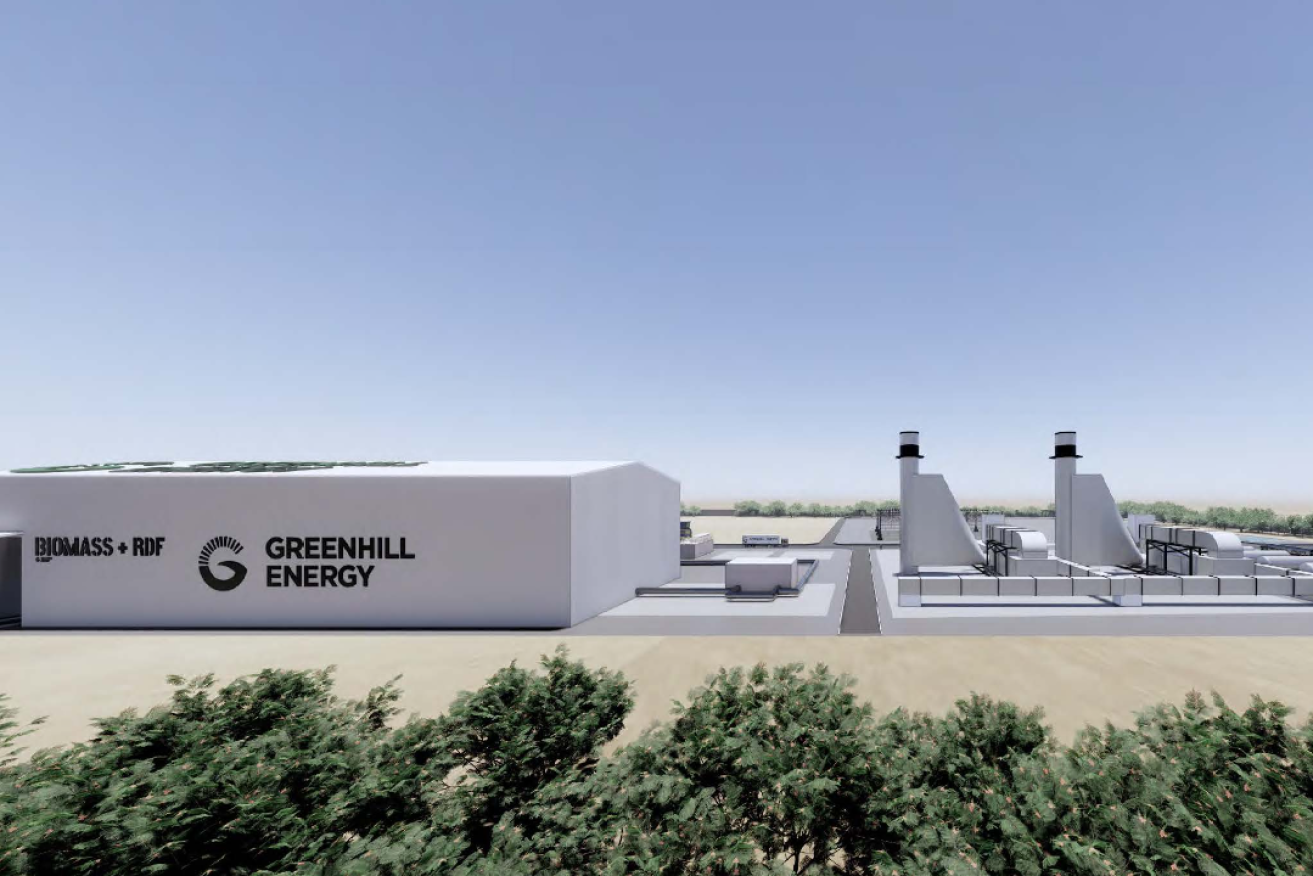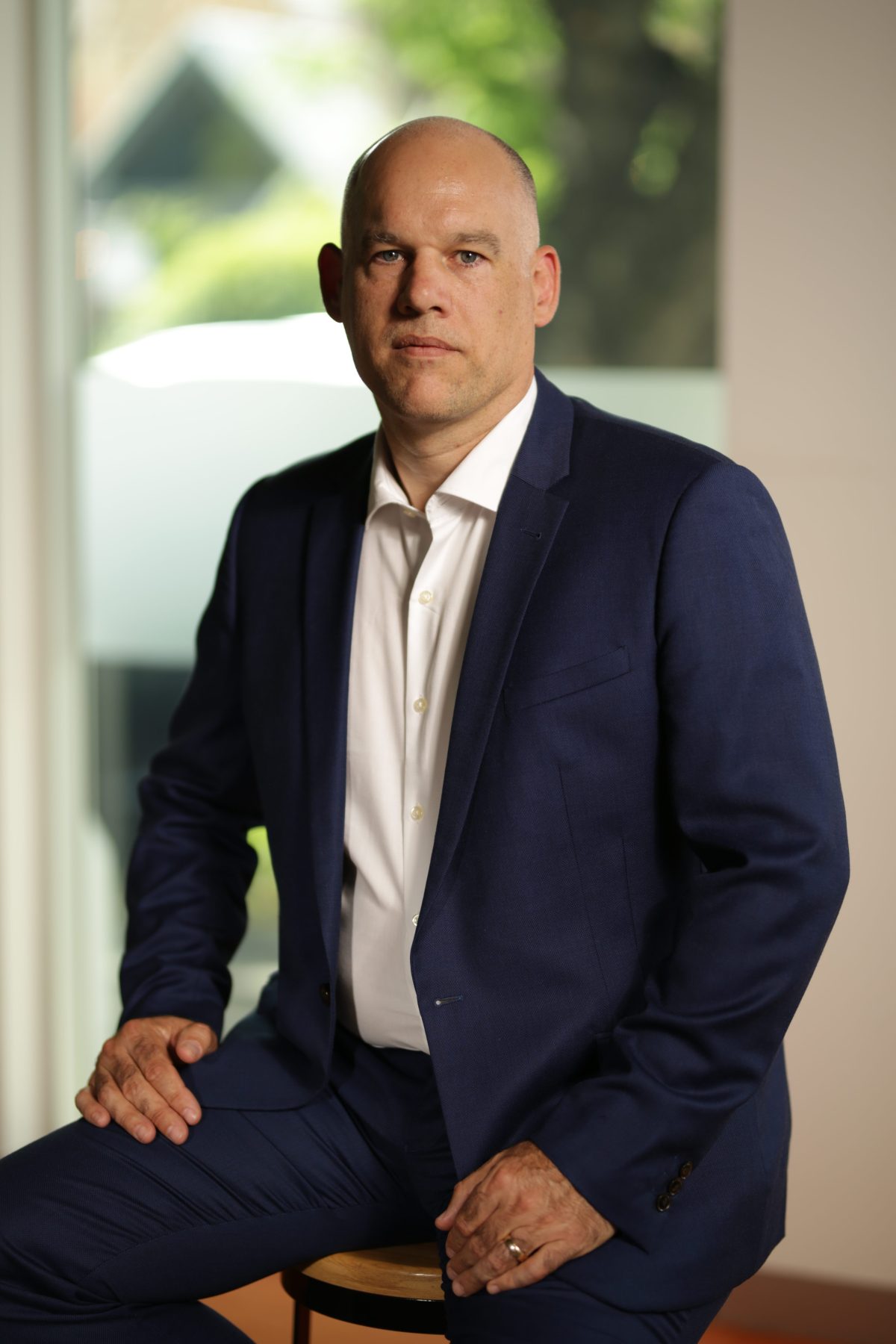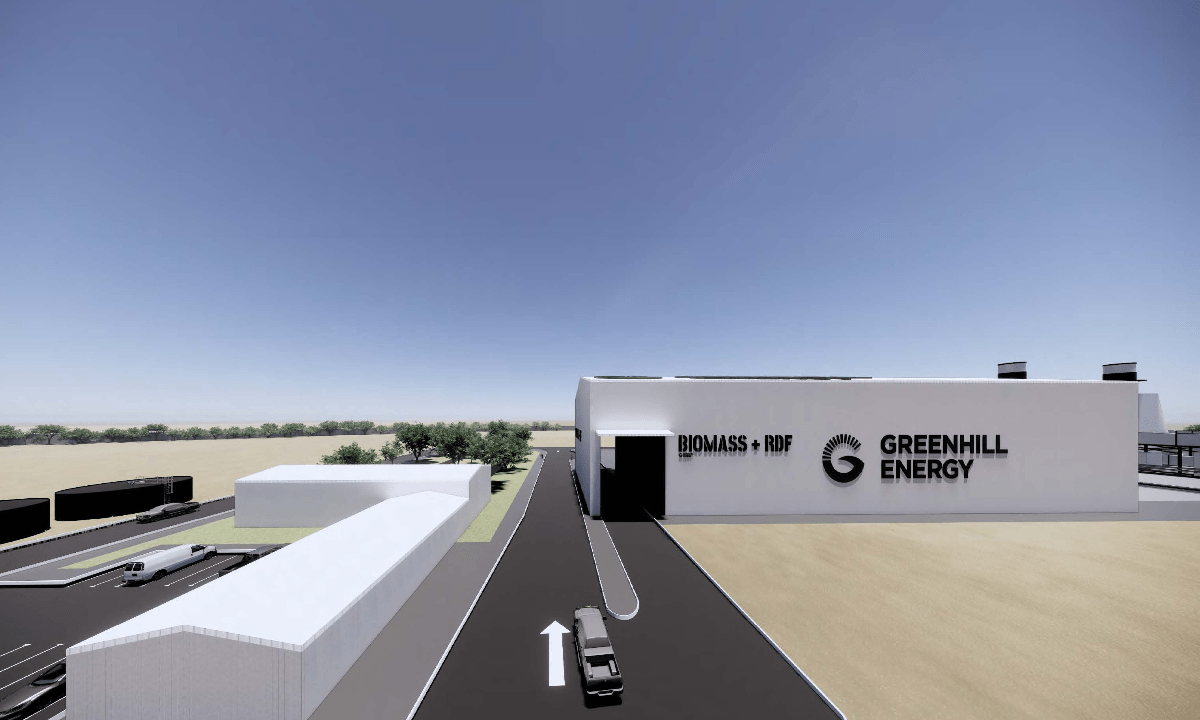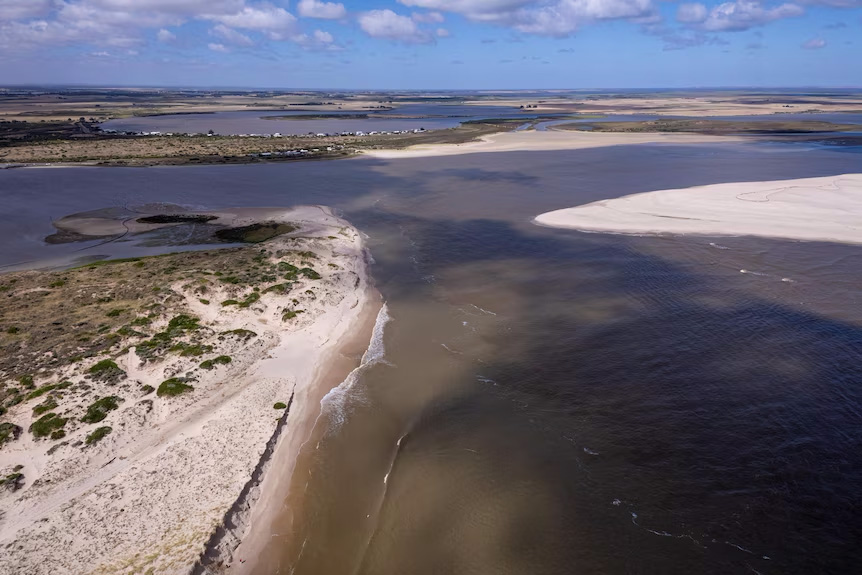Reposted from InDaily.
A more than $400 million plan from Greenhill Energy will divert up to 200,000 tonnes of waste per year from Australian landfills according to managing director Nicholas Mumford, who has big ideas for his Adelaide-based firm.

A render of Greenhill Energy’s proposed centre at Tailem Bend. Photo: Supplied.
With nine years at Santos under his belt and further experience at energy giant Shell, Nicholas Mumford is well-acquainted with the energy sector.
It was this time at Santos and Shell – the latter being one of the world’s biggest polluters – that inspired his work at Adelaide energy company Greenhill Energy.
The firm, based at Burnside, announced last year it would construct a $425 million integrated waste-to-hydrogen processing plant at Tailem Bend, south-east of Adelaide.
There the company will be able to divert up to 200,000 tonnes of waste from landfill once the facility is at full capacity, reducing greenhouse gas emissions in turn.
The Riverbend Energy Hub will turn waste and biomass into high-value products like fertilisers and synthetic fuels, and will also produce low-cost clean hydrogen for use in emission-free power and transport.
Speaking to InDaily, the managing director – who co-founded the business alongside chief technical officer Dr John Thomas – said his journey to starting Greenhill Energy was inspired by wanting to “address the broader climate change and emission reductions” issues.
“One of the drivers was to get out into the bigger wider world to be able to affect change quicker and more radically than I could sitting in a large corporate,” he said.
His decision to focus on hydrogen was made to avoid going for the “low-hanging fruit” like solar, and he was excited by hydrogen’s potential as a fuel source.

Greenhill Energy founder Nicholas Mumford. Photo: Supplied.
“Hydrogen is the jack of all trades, but it’s not the silver bullet for everything,” he said.
“Over the years hydrogen has been underutilised as a solution, simply because it’s been cost-prohibitive. I come from an oil and gas background and in many ways, hydrogen is very similar to oil and gas: it runs through pipelines, you have a similar set of standards for safety and hazard identification and so forth.
“A lot of the process, skills and background for oil and gas applies to the hydrogen sector. If we’re thinking about jobs into the future, a lot of the industry, the suppliers, the individuals that are in the oil and gas sector now in Australia and globally, for them to transition into a hydrogen-led economy in an emission-free sector then that transition is not a massive step.”
At the centre of Greenhill Energy’s plans is a $425 million integrated waste-to-hydrogen processing facility at Tailem Bend.
Once finished, it will be the first of its kind in Australia able to convert landfill waste and sustainable biomass into other products and clean hydrogen for use in power and transport.
The facility will sit on 20 hectares of land and should be fully operational within five years from now. Once at full capacity, it is expected to be able to manufacture more than 100,000 tonnes of urea fertilisers.
The project has State Government crown sponsorship, and, pending approvals, in 2025 the company will have constructed a singular gasifier that will be able to process 60,000 tonnes of waste per year – equivalent to about 1500 fully loaded semi-trailer trucks.
The company estimates about 300 jobs will be created during construction and once completed about 50 to 100 direct jobs.
In March, the company announced it had partnered with the City of West Torrens, Solo Resource Recovery and Peats Soil and Garden Supplies to establish a demonstration pilot program.
That demo will see the pre-processing of waste at the Adelaide Waste & Recycling Centre at North Plympton, followed by the processing of material to produce syngas using the University of Adelaide’s existing gasification facilities at its Thebarton campus.

A render of Greenhill Energy’s proposed project. Photo: Supplied.
“This partnership was formed with a broader vision to build an industrial scale facility to convert landfill waste into high-value products, such as clean hydrogen,” Mumford said at the time.
“This process will effectively mature Australia’s circular economy and contribute to considerable emission reductions in Australia’s waste sector.”
According to the International Energy Agency, methane is responsible for about 30 per cent of the rise in global temperatures post-industrial revolution.
“It’s a massive issue across the globe,” he said.
“We need to reduce our emissions a lot quicker than what we’re doing globally to hit our net zero targets, and we need to target the industries that have the biggest bang for your buck for the biggest impact.
“By diverting waste away from landfill, you’re not producing methane emissions. You put it through a process that does have a level of CO2 emission, but those CO2 emissions are utilised in an end-to-end process because we’re manufacturing products – higher-value products – from the material.”
He said his process “ticks a lot of boxes” in one go, “and provides jobs for the local community as well”.
The process he’s using has been adopted internationally, he said, but the urea fertiliser component of Greenhill’s project is “unique”.
“The downstream technology for urea is very conventional once you have the hydrogen and CO2 – that’s been done countless times globally – but taking the process through the whole end-to-end is a bit unique,” he said.
“What we’re trying to do is really uplift the value and upcycle the landfill waste into something of higher value so that we can actually start diverting away from landfill at a large scale.”
Further, there’s a “big opportunity internationally” too for Greenhill Energy which has a patent pending for its technology.
“We’re looking to leverage the technology internationally in due course, and we’re also looking at multiple facilities around Australia,” he said.
“There’s a really big opportunity internationally with what we’re talking about here. There’s 1.6 billion people in the world that don’t have electricity for example, and there’s a lot of waste that sits around the world and stockpiled in some of the countries that probably have very little net wealth.
Greenhill Energy Media Release
South Australia takes another step towards upcycling waste to manufacture clean hydrogen
Waste to Hydrogen project partners City of West Torrens, Solo Resource Recovery (Solo), Greenhill Energy and Peats Soil and Garden Supplies (Peats), in collaboration with the University of Adelaide, will embark on the next phase of their journey to divert waste from going to landfill in South Australia, and have agreed to work together to establish a demonstration pilot program.
The pilot scale demonstration project includes pre-processing of Municipal Solid Waste (MSW) at the Adelaide Waste & Recycling Centre (AWRC) located at North Plympton, followed by the processing of material to produce syngas using the University of Adelaide’s existing gasification facilities, located at its Thebarton campus.
Greenhill Energy Executive Managing Director Nicholas Mumford said this demonstration pilot program is the next logical step in the partnership formed in 2021 to investigate the technical, commercial and economic potential of manufacturing clean hydrogen from household waste which would otherwise be destined for landfill.
“This partnership was formed with a broader vision to build an industrial scale facility to convert landfill waste into high value products, such as clean hydrogen. This process will effectively mature Australia’s circular economy and contribute to considerable emission reductions in Australia’s waste sector. We’re excited to take another leap forward with this demonstration pilot program that will help inform the large scale upcycling of waste into low-cost clean hydrogen and high-value industrial products,” said Nicholas.
Read the full Press Release here >
Reposted from Australian Manufacturing
In a bid to break Australia’s heavy reliance on foreign imports for urea fertiliser, Greenhill Energy is set to launch the Riverbend Energy Hub in South Australia’s Murraylands.
This ambitious project aims to not only reduce the nation’s dependence on international markets but also bolster food security and promote sustainability in the agricultural sector, the company said in a media release.
The proposed manufacturing facility in Tailem Bend will be a pioneering project, integrating landfill waste and sustainable biomass to produce high-value products such as urea fertiliser, synthetic fuels, and clean hydrogen.
With partnerships already secured with industry giants like Elders, Solo Resource Recovery, and Peats Soil and Garden Supplies, Greenhill Energy is poised to divert biomass and waste materials into its processing facility starting from 2025.
Nicholas Mumford, executive managing director of Greenhill Energy, emphasised the importance of supporting local farmers while addressing Australia’s vulnerability to fluctuating international prices.
“We know our lack of sovereign capacity and resilience worries many people on the land. We aim to provide domestic supply certainty and place downward pressure on the cost of local food production,” stated Mumford.
The initiative comes at a crucial time when Australia’s dependence on foreign urea imports is escalating annually.
The closure of regional plants in 2022 further exacerbated the situation, leaving the nation entirely reliant on international sources.
However, Greenhill Energy’s innovative approach offers a sustainable solution by repurposing waste materials into valuable resources.
The Riverbend Energy Hub will utilise advanced waste-to-hydrogen technologies, including gasification, to produce “green urea” and clean hydrogen.
Initially targeting 100,000 tonnes of green urea production, Greenhill Energy aims to scale up operations to meet a significant portion of the nation’s urea needs in the future.
“We are proud to be one step closer to delivering Australia’s first fully integrated facility of this kind in regional South Australia to convert high volume sustainable biomass and landfill waste into high value upcycled products, such as urea fertiliser,” Mumford stressed.
Beyond addressing domestic Australian Manufacturing Greenhill Energy plans to replicate its success by establishing similar facilities across Australia and internationally.
Greenhill Energy Media Release
South Australia manufacturing facility set to reverse the trend of Australia’s heavy reliance on other countries for urea fertliser
Greenhill Energy’s proposed Riverbend Energy Hub is set to reverse Australia’s heavy reliance on other countries for urea fertiliser, while also increasing national food security and further ‘greening’ the primary industry sector.
The proposed urea manufacturing facility at Tailem Bend in South Australia’s Murraylands is set to become Australia’s first full integrated processing facility to convert landfill waste and sustainable biomass into high value products such as urea fertiliser and synthetic fuels, and into low-cost clean hydrogen for use in emission free power and transport.
The company has several MOUs in place with high calibre partners such as Elders, Solo Resource Recovery and Peats Soil and Garden Supplies to see the diversion of biomass and landfill waste into its proposed processing facility from 2025.
Greenhill Energy Executive Managing Director Nicholas Mumford said they also aim to support local farmers with their fertiliser needs, helping to increase domestic food security and as a practical circular economy demonstration of re-purposing biomass and landfill waste.
“Australia presently imports 100% of its urea needs, exposing domestic users to volatile and high-cost international pricing,” he said. “We know our lack of sovereign capacity and resilience worries many people on the land. We aim to provide domestic supply certainty and place downward pressure on the cost of local food production.
Read the full Media Release here >
Reposted from Wholesale Investor YouTube
Discover the innovative journey of Greenhill Energy as they transform everyday waste into clean hydrogen fuel, marking a new era in sustainable energy solutions.
This Exclusive Interview delves into the cutting-edge gasification technology that powers this transformation, the strategic partnerships driving success, and the environmental impact of reducing greenhouse gas emissions.
Join us to explore how Greenhill Energy is redefining the future of clean energy, one waste conversion at a time.
Greenhill Energy Media Release
Greenhill Energy commences Riverbend Energy Hub Front End Engineering and Design (FEED) site works
Greenhill Energy has undertaken geotechnical investigations at its proposed Riverbend Energy Hub site near Tailem Bend as a key milestone in progressing Front End Engineering and Design (FEED) for Riverbend Energy Hub, located near Tailem Bend, South Australia. The geotechnical work is a critical FEED parameter that informs the foundational requirements of the site build.
The site is strategically located within close proximity to the 275kV electricity transmission Heywood Interconnector, the South East Australia Gas (SEA Gas) high pressure gas pipeline, the freight roads connecting Adelaide with Melbourne and Sydney, and within the freight rail corridor.
Greenhill Energy plans to build Australia’s first fully integrated processing facility to convert landfill waste and sustainable biomass into high value products such as fertilisers and synthetic fuels, and into low-cost clean hydrogen for use in emission free power and transport.
Within five years, Greenhill Energy Executive Managing Director Nicholas Mumford said annually the waste-to-hydrogen facility, at full capacity, is expected to divert up to 200,000 tonnes of waste from landfill, reducing greenhouse gas emissions by avoiding release of environmentally harmful methane, with CO2 produced onsite used in the manufacturing of over 100,000 tonnes of urea fertilisers.
“We are excited to see the project making progress through FEED and, pending approvals, 2025 will see the construction of a single gasifier, in our first phase,” Mumford said. “This will be able to process up to 60,000 tonnes of dry biomass or waste per year, which is around 1,500 fully loaded semi-trailer trucks.”
“Riverbend Energy Hub’s stage one will also include an integrated power plant that will be able to provide firm power into the wholesale electricity market, and in turn, support further development of intermittent renewable energy generation types,” he said.
“We estimate that the project will create around 300 jobs, during construction. Once established and operating at full scale it is estimated there will be around 50 to 100 direct jobs, and no doubt further indirect jobs through sustainable biomass development and the like.”
Mumford said the project has been backed by a portfolio of early-stage private investors and significant industry partnerships, including MOUs with high calibre partners, such as Elders, Solo Resource Recovery and Peats Soil and Garden Supplies.
Read the full Press Release here >
Reposted from the Australian Financial Review (AFR) – Street Talk
Greenhill Energy, a business led by former Santos operative Nicholas Mumford, has begun meeting with investors as it seeks funding to build a waste-to-hydrogen facility that hopes to divert more than 20 per cent of South Australia’s landfill waste by 2030.
Reposted from ABC Riverland
Planning is underway for a $425 million hydrogen project in regional South Australia, which is set to create about 300 jobs during construction.
The Riverbend Energy Hub is proposed for Tailem Bend, about an hour from Adelaide, and would convert 200,000 tonnes of landfill into hydrogen annually within five years of operation.
Spearheaded by Adelaide-based company Greenhill Energy, the project would create ongoing jobs, says chief executive Nicholas Mumford.
“There will be around 300 through construction and we expect around 50 to 100 direct employees through operation, but there are other avenues for employment indirectly,” he said.
The project, which is in approval stages, could begin construction in 2025.
It would use a gasification process to turn landfill into hydrogen, which would then be used to make 100,000 tonnes of urea — used in the manufacture of fertilisers, plastics and adhesives — per year once it reached full capacity.
A report released by the Grattan Institute this month found ammonia, which is used to create urea, is one of the three uses of green hydrogen that Australia should focus on producing domestically, due to its use in fertiliser for farmers.

But what is hydrogen?
Hydrogen is an abundant, flammable gas that can be used as a fuel for electricity or burnt as a heat source.
It can be used in its naturally occurring form, or it can be created synthetically, as the Riverbend Energy Hub would do.
When created, hydrogen is classed by a colour system based on the amount of emissions generated or released by the manufacturing process.
Brown hydrogen is created by burning coal, with the emissions released into the atmosphere, while blue hydrogen is produced with natural gas, with the emissions captured and stored.
While there are other methods of producing hydrogen, the Riverbend Energy Hub would use gasification and produce a green hydrogen from landfill.
Mr Mumford said gasification heats up the landfill to high temperatures, converting it into gasses, and the hydrogen is separated from the carbon dioxide.
He said while the technology is used in the United States and Europe, it is not yet used in Australia.
“The technology itself is well proven in its component parts, but this is the first of its proposed kind in Australia,” he said.
“The opportunity here is the diversion of waste from the landfill, and the important benefit here is we’re reducing greenhouse gas emissions by doing so.”
‘Really sustainable’

Adelaide University post doctorate research fellow Rachelle Kernen said projects like this are important the future.
Dr Kernen said the gasification process would heat and convert organic matter into gases, including hydrogen, without any combustion.
“If you use a waste product in this, it can actually be a really sustainable and effectively no-CO2 emission option for generating hydrogen power,” she said.
“Projects like this are going to be essential now and moving forward.
“It’s going to be imperative that we reduce emissions, like CO2 and methane — we’re going to need to really work hard at reducing and minimising emissions that contribute to climate change.”
Community benefits

Back in regional SA, Regional Development Australia Murraylands and Riverland chief executive Ben Fee said the Riverbend Energy Hub would be an exciting investment in a more renewable future for the area.
“We’ve got issues around climate change that we have to adapt to … [we have to] transform our industries, businesses and communities to make sure that we’re set up for the next two, three five or 10 generations,” he said.
“This is world leading type of stuff, which absolutely fits with RDA Murraylands and Riverland’s vision that we’ll be an internationally recognised, vibrant and world leading circular economy by 2030.”
Greenhill Energy Media Release
Greenhill Energy launches $425 million plans to construct Australia’s first large scale integrated waste-to-hydrogen processing facility in South Australia.
Greenhill Energy has launched their $425 million plans to build Australia’s first full integrated processing facility to convert landfill waste and sustainable biomass into high value products such as fertilisers and synthetic fuels, and into low-cost clean hydrogen for use in emission free power and transport.
Following recent positive trials and ongoing research and development, Greenhill Energy has secured 20 hectares of land at Tailem Bend in South Australia’s Murraylands for their flagship clean hydrogen project, The Riverbend Energy Hub™.
Within 5 years, Greenhill Energy Executive Managing Director Nicholas Mumford said annually the waste-to-hydrogen facility, at full capacity, is expected to divert up to 200,000 tonnes of waste from landfill, reducing greenhouse gas emissions by avoiding release of environmentally harmful methane, with CO2 produced onsite used in the manufacturing of over 100,000 tonnes of urea fertilisers.
“We have been granted State Government crown sponsorship across the project and, pending approvals, 2025 will see the construction of a singular gasifier, in our first phase,” Mumford said. “This will be able to process up to 60,000 tonnes of dry biomass or waste per year, which is around 1,500 fully loaded semi-trailer trucks.
“Riverbend Energy Hub’s stage one will also include an integrated power plant that will be able to provide firm power into the wholesale electricity market, and in turn, support further development of intermittent renewable energy generation types,” he said.
“We estimate thet the project will create around 300 jobs, during construction. Once established and operating at full scale it is estimated there will be around 50 to 100 direct jobs, and no doubt further indirect jobs through sustainable biomass development and the like.”
The project will be underpinned by integrating proven hydrogen processing and manufacturing technologies, within a unique closed system, as Australia’s economy and industry seeks to decarbonise.
Read the full Press Release here >
Reposted from the Australian Financial Review (AFR)
Greenhill Energy, a business aiming to construct a $425 million waste-to-hydrogen plant in rural South Australia, is preparing for a capital raising to advance the project which will also produce fertiliser and synthetic fuels.
Managing director Nicholas Mumford, a former executive with Santos, said the group had successfully completed trials in Europe of the gasification process, and was heading into the next stage of the Riverbend Energy Hub project.